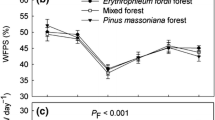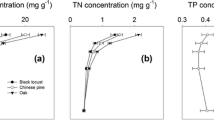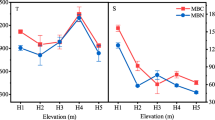Abstract
Background, Aims, and Scope
An improved understanding of important soil carbon (C) and nutrient pools as well as microbial activities in forest ecosystems is required for developing effective forest management regimes underpinning forest productivity and sustainability. Forest types and management practices can have significant impacts on soil C and nutrient pools as well as biological properties in forest ecosystems. Soil C and nutrient pools were assessed for adjacent natural forest (NF), first rotation (1R) (50-year-old), and second rotation (2R) (1-year-old) hoop pine (Araucaria cunninghamii Ait. ex D. Don) plantations in southeast Queensland of subtropical Australia.
Materials and Methods
Five transects spaced 3 m apart with 9 sampling points along each transect were selected (9.6 m × 12.0 m each site), with 45 soil cores (7.5 cm in diameter) collected and separated into 0–10 and 10–20 cm depths. These soils were analysed for total C, total nitrogen (N), C (δ13C) and N (δ15N) isotope composition. The 0–10 cm soils were analysed for pH, CEC, exchangeable cations, total P and total K, and assayed for microbial biomass C and N, respiration, metabolic quotient, potential mineralizable N (PMN), gross N mineralization (M) and immobilization (I).
Results
Total C and N in 0–10 cm soils were higher under NF and 1R plantation than under 2R plantation, while they were highest in 10–20 cm soils under NF, followed by the 1R and then 2R plantation. δ13C was lower under NF than under the plantations, while δ15N was higher under NF than under the plantations. Total P was the highest under NF, followed by the 1R and then 2R plantation, while total K was higher under the 2R plantation. No significant differences were detected for pH, CEC, exchangeable cations, microbial C and N, respiration and metabolic quotient among the 3 sites. PMN and M were higher under NF, while I was the highest under the 2R plantation, followed by the NF and then 1R plantation.
Discussion
Soil total C and N in 0–10 cm depth were significantly lower under 2R hoop pine plantation than those under NF and 1R hoop pine plantation. There were significant reductions in soil total C and N from NF to 1R and from 1R to 2R hoop pine plantations in 10–20 cm depth. This highlights potential N deficiency in the 2R hoop pine plantations, and application of N fertilizers may be required to improve the productivity of 2R hoop pine plantations.
There were no significant differences in other soil chemical and physical properties in 0–10 cm depth among the 3 sites under NF, 1R and 2R hoop pine plantations, except for soil total P and K.
Soil microbial biomass C, CO2 respiration and metabolic quotient did not differ among the 3 sites assessed, perhaps mainly due to these biological variables being too sensitive to variations in soil chemical and physical properties and thereby being associated with a larger variability in the soil biological properties. However, soil potential mineralizable N, gross N mineralization and immobilization were rather sensitive to the conversion of NF to hoop pine plantation and forest management practices.
Conclusions
Total C and N in the top 20 cm soil were highest under NF, followed by 1R and then 2R hoop pine plantations, indicating that N deficiency may become a growth-limiting factor in the 2R hoop pine plantations and subsequent rotations of hoop pine plantation. The sample size for soil δ13C seems to be much smaller than those for soil total C and N as well as δ15N. The significant reductions in soil total P from NF to 1R and then from 1R to 2R hoop pine plantations highlight that P deficiency might become another growth-limiting factor in the second and subsequent rotations of hoop pine plantations. Soil microbial properties may be associated with large spatial variations due to these biological properties being too sensitive to the variations in soil chemical and physical properties in these forest ecosystems.
Recommendations and Perspectives
Soil potential mineralizable N, gross N mineralization and immobilization were useful indices of soil N availability in response to forest types and management practices. The sampling size for soil δ13C was much smaller than the other soil chemical and biological properties due to the different patterns of spatial variation in these soil properties.
Similar content being viewed by others
References
Bastias BA, Anderson IC, Xu ZH, Cairney JWG (2007): RNA-and DNA-based profiling of soil fungal communities in native Australian eculypt forest and adjacent Pinus elliottii plantation. Soil Biol Biochem 39, 3108–3114
Bastias BA, Huang ZQ, Blumfield T, Xu ZH, Cairney JWG (2006a): Influence of repeated prescribed burning on the soil fungal community in an eastern Australian wet sclerophyll forest. Soil Biol Biochem 38, 3492–3501
Bastias BA, Xu ZH, Cairney JWG (2006b): Influence of long-term repeated prescribed burning on mycelial communities of ectomycorrhizal fungi determined by DGGE profiling of DNA from hyphal ingrowth bags. New Phytol 172, 149–158
Bengtsson G, Bengtson P, Månsson KF (2003): Gross nitrogen mineralization-, immobilization-, and nitrification rates as a function of soil C/N ratio and microbial activity. Soil Biol Biochem 35, 143–154
Blumfield TJ, Xu ZH (2003): Impact of harvest residues on soil mineral nitrogen dynamics in the first two years of hoop pine plantation in subtropical Australia. For Ecol Manage 179, 55–69
Blumfield TJ, Xu Z, Prasolova NV, Mathers NJ (2006): Effect of Overlying Windrowed Harvest Residues on Soil Carbon and Nitrogen in Hoop Pine Plantations of Subtropical Australia. J Soils Sediments 6(4) 243–248
Blumfield TJ, Xu ZH, Prasolova NP (2007): Sampling size required for determining soil carbon and nitrogen properties at early establishment of second rotation hoop pine plantations in subtropical Australia. Pedosphere 17, 706–711
Bubb KA, Xu ZH, Simpson JA, Saffigna PG (1998): In situ measurements of soil mineral nitrogen fluxes in hoop pine plantations of subtropical Australia. N Z J For Sci 28, 152–164
Bubb KA, Xu ZH, Simpson JA, Saffigna PG (1999): Growth response to fertilization and recovery of 15N-labelled fertilizer by young hoop pine plantations of subtropical Australia. Nutr Cycl Agroecosys 54, 81–92
Burton J, Chen CR, Xu ZH, Ghadiri H (2007a): Gross nitrogen transformations in adjacent native and plantation forests of subtropical Australia. Soil Biol Biochem 39, 426–433
Burton J, Chen CR, Xu ZH, Ghadiri H (2007b): Soluble organic nitrogen pools in adjacent native and plantation forests of subtropical Australia. Soil Biol Biochem 39, 2723–2734
Carlyle JC (1994): Opportunities for managing nitrogen uptake in established Pinus radiata plantations on sandy soils. N Z J For Sci 24, 344–361
Carlyle JC, Bligh MW, Nambiar EKS (1998): Woody residue management to reduce nitrogen and phosphorus leaching from sandy soil after clear-felling Pinus radiata plantations. Can J For Res 28, 1222–1232
Chen CR, Xu ZH (2006): On the nature and ecological functions of soil soluble organic nitrogen (SON) in forest ecosystems. J Soils Sediments 6, 63–66
Chen CR, Xu ZH, Blumfield TJ, Hughes JM (2003): Soil microbial biomass during the early establishment of hoop pine plantation: seasonal variation and impacts of site preparation. For Ecol Manage 186, 213–225
Chen CR, Xu ZH, Hughes JM (2002): Effects of nitrogen fertilization on soil nitrogen pools and microbial properties in a hoop pine (Araucaria cunninghamii) plantation in southeast Queensland, Australia. Biol Fertil Soils 36, 276–283
Chen CR, Xu ZH, Mathers NJ (2004) Soil carbon pools in adjacent natural and plantation forests of subtropical Australia. Soil Sci Soc Am J 68, 282–291
He JZ, Xu ZH, Hughes J (2005): Soil fungal communities in adjacent natural forest and hoop pine plantation ecosystems as revealed by molecular approaches based on 18S rRNA genes. FEMS Microbiol Lett 247, 91–100
He JZ, Xu ZH, Hughes J (2006): Molecular bacterial diversity of a forest soil under different residue management regimes in subtropical Australia. FEMS Microbiol Ecol 55, 38–47
Hirobe M, Tokuchi N, Iwatsubo G (1998): Spatial variability of soil nitrogen transformation patterns along a forest slope in a Cryptomeria japonica D. Don plantation. E J Biol 34, 123–131
Laverman AM, Zoomer HR, van Verseveld HW, Verhoef HA (2000): Temporal and spatial variation of nitrogen transformations in a coniferous forest soil. Soil Biol Biochem 32, 1661–1670
Makarov MI, Glaser B, Zech W, Malysheva TI, Bulatnikova IV, Volkov AV (2003): Nitrogen dynamics in alpine ecosystems of the northern Caucasus. Plant Soil 256, 389–402
Mao XA, Xu ZH, Luo RS, Mathers NJ, Zhang YH, Saffigna PG (2002): Nitrate in soil humic acids revealed by nitrogen-14 nuclear magnetic resonance spectroscopy. Aust J Soil Res 40, 717–726
Mathers NJ, Xu ZH (2003): Solid-state 13C NMR spectroscopy: Characterization of soil organic matter under two constrasting residue management regimes in a 2-year-old pine plantation of subtropical Australia. Geoderma 114, 19–31
Mathers NJ, Xu ZH, Blumfield TJ, Berners-Price SJ, Saffigna PG (2003): Composition and quality of harvest residues and soil organic matter under windrow residue management in young hoop pine plantations as revealed by solid-state 13C NMR spectroscopy. For Ecol Manage 175, 467–488
Morris SJ, Boerner REJ (1999): Spatial distribution of fungal and bacterial biomass in southern Ohio hardwood forest soils: scale dependency and landscape patterns. Soil Biol Biochem 31, 887–902
Murphy DV, Bhogal A, Shepherd M, Goulding KWT, Jarvis SC, Barraclough D, Gaunt JL (1999): Comparison of 15N labelling methods to measure gross nitrogen mineralization. Soil Biol Biochem 31, 2015–2024
Neill C, Piccolo MC, Melillo JM, Steudler PA, Cerri CC (1999): Nitrogen dynamics in Amazon forest and pasture soils measured by 15N pool dilution. Soil Biol Biochem 31, 567–572
Prasolova NV, Xu ZH (2003): Genetic variation in branchlet nutrient concentrations at different canopy positions in relation to branchlet δ13C and δ18O and tree growth of 8–9 years old hoop pine families in two contrasting growing environments. Tree Physiol 23, 675–684
Prasolova NV, Xu ZH, Farquhar GD, Saffigna PG, Dieters MJ (2000a): Variation in canopy δ13C of 8-year-old hoop pine families (Araucaria cunninghamii) in relation to canopy nitrogen concentration and tree growth in subtropical Australia. Tree Physiol 20: 1049–1055
Prasolova NV, Xu ZH, Farquhar GD, Saffigna PG, Dieters MJ (2001): Canopy carbon and oxygen isotope composition of 9-year-old hoop pine families in relation to seedling carbon isotope composition and growth, field growth performance and canopy nitrogen concentration. Can J For Res 31, 673–681
Prasolova NV, Xu ZH, Lundkivst K (2005): Genetic variation in foliar nutrient concentration in relation to foliar carbon isotope composition and tree growth in clones of the F1 hybrid between slash pine and Caribbean pine. For Ecol Manage 210, 172–191
Prasolova NV, Xu ZH, Saffigna PG, Dieters M (2000b): Spatial-temporal variability of soil moisture, nitrogen availability indices and other chemical properties in hoop pine (Araucaria cunninghamii) plantations of subtropical Australian forest plantations. For Ecol Manage 136, 1–10
Pu GX, Saffigna PG, Xu ZH (2001): Denitrification, leaching and immobilisation of 15N-labelled nitrate in winter under windrowed harvesting residues in 1 to 3-year-old hoop pine plantations of subtropical Australia. For Ecol Manage 152, 183–194
Rayment MB, Jarvis PG (2000): Temporal and spatial variation of soil CO2 efflux in a Canadian boreal forest. Soil Biol Biochem 32, 35–45
Riha SJ, James BR, Senesac GP, Pallant E (1986): Spatial variability of soil pH and organic matter in forest plantations. Soil Sci Soc Am J 50, 1347–1352
Saetre P, Bååth E (2000): Spatial variation and patterns of soil microbial community structure in a mixed spruce-birch stand. Soil Biol Biochem 32, 909–917
Soil Survey Staff (1999): Soil Taxonomy A Basic System of Soil Classification for Making and Interpreting Soil Surveys (2nd ed). USDA Soil Conservation Service, Washington
Verchot LV, Holmes Z, Milon L, Groffman PM, Lovett GM (2001): Gross vs net rates of N mineralization and nitrification as indicators of functional differences between forest types. Soil Biol Biochem 33, 1889–1901
Wang WJ, Chalk PM, Chen DL, Smith CJ (2001): Nitrogen mineralization, immobilization and loss, and their role in determining differences in net nitrogen production during waterlogged and aerobic incubation of soils. Soil Biol Biochem 33, 1305–1315
Xu ZH, Bubb KA, Simpson JA (2002): Improved nitrogen nutrition and growth of Araucaria cunninghamii plantation from application of nitrogen fertilizer and weed control to 4-year-old stands in subtropical Australia. J Trop For Sci 14, 213–222
Xu ZH, Chen CR (2006): Fingerprinting global climate change and forest management within rhizosphere carbon and nutrient cycling processes. Env Sci Pollut Res 13, 293–298
Xu ZH, Ladd JN, Elliott DE (1996): Soil nitrogen availability in the cereal zone of South Australia. I. Soil organic carbon, total nitrogen and nitrogen mineralization rates. Aust J Soil Res 34, 937–948
Xu ZH, Prasolova NV, Lundkvist K, Beadle C, Leaman T (2003): Genetic variation in carbon and nitrogen isotope composition and nutrient concentration in the foliage of 10-year-old hoop pine families in relation to tree growth in subtropical Australia. For Ecol Manage 186, 359–371
Xu ZH, Simpson JA, Osborne DO (1995): Mineral nutrition of slash pine in subtropical Australia. I. Stand growth response to fertilization. Fert Res 41, 93–100
Xu ZH, Wiseman D, Bubb KA, Ding WX, Prasolova NV, Saffigna PG, Simpson JA (2000): Canopy N and water use efficiency, tree growth and fate of 15N-labelled fertilizer in the first 4 years after fertilization of 7-year-old hoop pine plantation in Queensland. In: Adams JA and Metherell AK (eds), Proceedings of the Soil 2000 Conference: New Horizons for a New Century, 3–8 December 2000, NZSSS and ASSSI. Lincoln University, Canterbury, New Zealand, pp 341–342
Author information
Authors and Affiliations
Corresponding author
Rights and permissions
About this article
Cite this article
Xu, Z., Ward, S., Chen, C. et al. Soil carbon and nutrient pools, microbial properties and gross nitrogen transformations in adjacent natural forest and hoop pine plantations of subtropical Australia. J Soils Sediments 8, 99–105 (2008). https://doi.org/10.1065/jss2008.02.276
Received:
Accepted:
Published:
Issue Date:
DOI: https://doi.org/10.1065/jss2008.02.276




